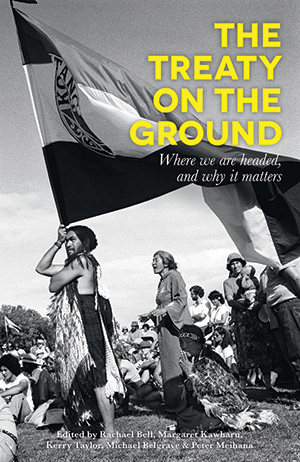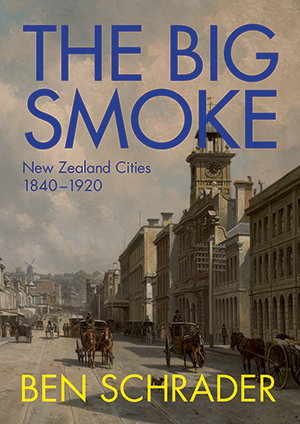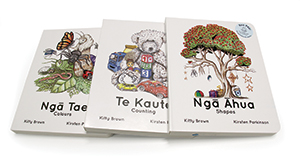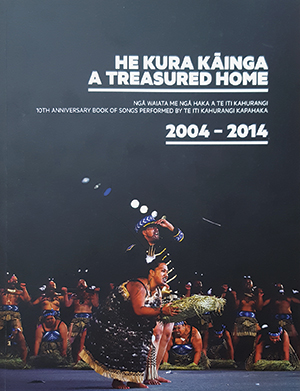Reviews Books
Jul 3, 2017

The Treaty On The Ground: Where we are headed, and why it matters
Edited by Rachel Bell, Margaret Kawharu, Kerry Taylor, Michael Belgrave, and Peter Meihana
Massey University Press, 2017
RRP: $39.99
Review nā Gerry Te Kapa Coates
 This book came from a “Treaty on the Ground” conference held in 2016 at Tāmaki Paenga Hira Auckland War Museum. It is a sometimes awkward attempt to cover the wide-ranging offerings of some of the participants. The phrase “Treaty on the Ground” is from Pākehā historian Ruth Ross’ 1972 piece attacking the “woolly-mindedness” that had allowed the Treaty to become all things to all people. The conference covered developments from 1945 to the present – although David Williams also traces links to Te Tiriti back to the Magna Carta – with a broad variety of offerings. Of the authors, 10 are Pākehā and six are Māori – an imbalance for sure, but not one that shows. Some of the papers are broad and survey the period well, reminding me again of the major – and smaller – issues between Māori and Pākehā in the Treaty space since 1945.
This book came from a “Treaty on the Ground” conference held in 2016 at Tāmaki Paenga Hira Auckland War Museum. It is a sometimes awkward attempt to cover the wide-ranging offerings of some of the participants. The phrase “Treaty on the Ground” is from Pākehā historian Ruth Ross’ 1972 piece attacking the “woolly-mindedness” that had allowed the Treaty to become all things to all people. The conference covered developments from 1945 to the present – although David Williams also traces links to Te Tiriti back to the Magna Carta – with a broad variety of offerings. Of the authors, 10 are Pākehā and six are Māori – an imbalance for sure, but not one that shows. Some of the papers are broad and survey the period well, reminding me again of the major – and smaller – issues between Māori and Pākehā in the Treaty space since 1945.
Massey University History Professor Michael Belgrave surveys the period of the 1961 Hunn report, which had a very limited view of the future for Māori as being in a private realm, rather than a “public world of universal participation.” It took until 1967 for a critique of these ideas as “a threat to Māori tribal identity” to emerge, in the face of Prime Minister Keith Holyoake’s attempts to implement Hunn’s recommendations over Māori land. Younger Māori like Donna Awatere and her book Māori Sovereignty began a debate about the politics of race, and provided a rallying cry for her generation of Māori or “black” women, including Ripeka Evans. Victoria University History Lecturer Cybèle Locke provides a good history of “Māori Radicalism and Trade Unions” from 1967–86. Familiar names from the union movements like Tama Poata, who spearheaded the Māori Organisation on Human Rights, and Syd Jackson, who formed Ngā Tamatoa, come to the fore. Massey University Lecturer in Māori History Dr Peter Meihana (Ngāti Kuia, Rangitāne, Ngāti Apa ki te Rā Tō, Ngāi Tahu) covers the idea that Māori were seen as “privileged” by settlers – by having the good fortune to have their land converted to titles under English law, and also being subject to the on-again off-again Crown pre-emption right under the Treaty.
Auckland consultant and Crown settlement negotiator Michael Dreaver gives a personal account of how Treaty Settlements were dealt with in practice from his many roles in the negotiation processes. He examines what has changed in the last 20 years as a result of Treaty settlements, citing that despite the efforts of Hana O’Regan in providing visionary leadership in promoting te reo, there are still just two kura kaupapa in Christchurch – the same as 30 years ago.
Dr Te Kawehau Hoskins of the University of Auckland covers Waitangi Tribunal hearings in a rather academic treatise. She makes the point that “for Māori the relation is everything” through whakapapa, compared with the Western idea of the “self-positing autonomous individual as the dominant model of personhood.” Social justice advocate Dr Kim Workman writes on the Treaty and the State Sector, and singles out the 1991 budget cuts to benefit levels as the major cause of why one quarter of New Zealand’s children are now living below the poverty line. Massey University lecturer in Māori Environmental and Resource Planning
Dr April Bennett looks at the Māori struggle to protect the environment, culminating in the Resource Management Act 1991 – an “important shift in the ‘monocultural’ landscape of environmental planning, the RMA now including Māori people and values.” Biddy Livesey, who specialises in Māori urban development, gives a lively discourse on how local government plans acknowledge – or otherwise – Treaty settlements, using the Waikato-Tainui aspirations as examples. As it happens, I was on the Ruakura Plan Change Board of Inquiry that enabled the Tainui inland port proposal, and perhaps set a precedent in allowing land returned as redress to be used to provide a future income stream for the tribe.
On the whole, this book is a useful and important addition to Treaty literature.
 Gerry Te Kapa Coates (Ngāi Tahu, Waihao) was born in Ōāmaru, and is an author of poetry – a collection of poems and short stories called The View From Up There (2011) – and widely varied non-fiction. He is a consultant working on hearings as a commissioner and Māori advisory work.
Gerry Te Kapa Coates (Ngāi Tahu, Waihao) was born in Ōāmaru, and is an author of poetry – a collection of poems and short stories called The View From Up There (2011) – and widely varied non-fiction. He is a consultant working on hearings as a commissioner and Māori advisory work.
The Big Smoke: New Zealand Cities 1840–1920
Nā Ben Schrader
Bridget Williams Books, 2016
RRP: $59.99
Review nā Dan Bartlett
 Perhaps best known for his wonderful history of state housing in New Zealand We Call it Home, Wellington-based historian Ben Schrader is certainly no stranger to our country’s urban past. His new monograph, The Big Smoke: New Zealand Cities 1840–1920, is not only detailed, informative and well-researched, but it is brimming with the voices of everyday people; making it an absolute delight to read. Covering the period from 1840, when Wellington was founded, to 1920 when New Zealand was becoming a post-colonial society distinct from Britain, Schrader’s book focuses on our four main cities: Auckland, Wellington, Christchurch, and Dunedin.
Perhaps best known for his wonderful history of state housing in New Zealand We Call it Home, Wellington-based historian Ben Schrader is certainly no stranger to our country’s urban past. His new monograph, The Big Smoke: New Zealand Cities 1840–1920, is not only detailed, informative and well-researched, but it is brimming with the voices of everyday people; making it an absolute delight to read. Covering the period from 1840, when Wellington was founded, to 1920 when New Zealand was becoming a post-colonial society distinct from Britain, Schrader’s book focuses on our four main cities: Auckland, Wellington, Christchurch, and Dunedin.
Seeking to challenge the anti-urbanism inherent in New Zealand historiography, and to provide a “counterweight to the strongly masculine reading of colonial society”, Schrader’s book is also a clarion call for further New Zealand urban history research. His hope is that The Big Smoke “provides a starting point for better understanding of why between 1840 and 1920 hundreds of thousands of New Zealanders chose to live in cities rather than the countryside”. Schrader argues that, with the exception of Erik Olssen and the ground-breaking Caversham Project in Dunedin (a multi-disciplinary study of the city’s southern suburbs from 1881 to 1940), anti-urbanism has maintained a “vice-like hold on New Zealand society and culture [that] has extended to historians, who have generally championed the idea that cities were handmaidens to the shaping of a strongly ruralised society”. Two of our most well-known histories, Jock Phillips’ A Man’s Country? and Miles Fairburn’s The Ideal Society and its Enemies, are rural-centric, and, pointing to the most recent edition of The Oxford History of
New Zealand (2007), Schrader laments that towns and cities “barely rate a mention”.
Uninterested in nostalgia for a bucolic past that the majority of New Zealanders did not experience, Schrader wends his way along city streets on Saturday nights. Street scenes that feel at once both foreign and familiar populate the chapter City Crowds. The theatrical street ritual of “doing the block” was the Antipodean answer to the British promenade, and involved “traversing a section of a city’s main street and being seen by one’s peers.” Beginning at one end, individuals, couples, and groups “would amble along the footpath, acknowledging friends and acquaintances, sometimes stopping to chat, and then, on reaching the end of the block, turn around and walk back to the start.” Doing the block was a bourgeois ritual, however; so it was left to Saturday night to mix social classes. Cuba Street in Wellington was a “stream of humanity”; the “congested footpaths” were populated with “all sorts and conditions of men, women, and children” enjoying their Saturday evening out. Although one contemporary observer recorded that “Auckland’s ladies seem to be overwhelmed with ennui”, it was arguably the social aspect of cities that was most attractive to settlers. City-dwellers joined clubs, societies, and institutes; they patronised museums, theatres and art galleries; they promenaded and they protested.
Schrader discusses Māori not as passive dwellers being shaped by the city, but instead as city-builders and shapers of metropolitan social and cultural life in their own right. The chapter on Māori experience of the cities “charts the marginalisation of Māori in New Zealand’s cities, but also considers some of the ways Māori continued to exert their agency in city spaces.” Māori dominated the fresh produce trade in the 1840s, with Bishop Selwyn observing that Nelson residents were almost totally reliant on Māori-supplied foodstuffs and fuel, but when Pākehā settlers began to feel threatened by Māori commercial interests they marginalised them, arguing that cities should be white places; their racism reinforced by the experience of the New Zealand Wars. But Pākehā city-dwellers were never unified in their views on Māori, and many encouraged them to the new urban centres – native hostelries were constructed and cultural performances were well-attended.
Schrader asserts that “the hackneyed images of taciturn and rugged outdoors men, the mustering and shearing of sheep, and romantic backblocks sheds no longer resonate with how New Zealanders see themselves – if they ever did.” Indeed, when Speight’s made their Southern Man redundant in 2012, the beer company’s marketing manager explained that the urbanisation of New Zealand meant the relevance of outdoor life had changed. The Big Smoke persuasively argues that the rebranding may have come a century too late.
We forget our past at our peril, and I applaud Schrader’s rallying cry for further New Zealand urban history research. I also congratulate him on an excellent book.
 Dan Bartlett is a researcher and writer with the Ngāi Tahu archives team
Dan Bartlett is a researcher and writer with the Ngāi Tahu archives team
Rua – Reo Pēpi Series 2
Kitty Brown and Kirsten Parkinson
Reo Pēpi, 2017
RRP: $49.99
Review nā Waipounamu Te Karu
 When I heard about the second series of Reo Pēpi pukapuka I was so excited, as my 19 month old son absolutely loves the first series. He especially loves the Kanohi – My Face book and I can tell it has helped him to understand the reo – he quickly learned to imitate the “arero/tongue” page by sticking out his own tongue, and he literally kisses the “ngutu/lips” page. So I was intrigued to see how he would react to the second series.
When I heard about the second series of Reo Pēpi pukapuka I was so excited, as my 19 month old son absolutely loves the first series. He especially loves the Kanohi – My Face book and I can tell it has helped him to understand the reo – he quickly learned to imitate the “arero/tongue” page by sticking out his own tongue, and he literally kisses the “ngutu/lips” page. So I was intrigued to see how he would react to the second series.
The box-set of three pukapuka includes Ngā Āhua – Shapes, Ngā Tae – Colours, and Te Kaute – Counting. Even though my son isn’t speaking yet, he tries his best to repeat after me as I count with him using Te Kaute – Counting. Sometimes he sits by himself and flicks through the books, so I know he really enjoys the pictures too. The books are made of heavy card, which is great as they stand up to the wear and tear (and kisses) of a toddler.
I am passionate about the revitalisation of te reo Māori so these are a great resource to have at home for my son, and in the homes of all pēpi throughout the country as there aren’t enough reo Māori books for our tamariki. The books are really fun and easy, and are a great tool to teach tamariki the basics in te reo Māori. Whether you’re raising your tamariki in a reo-speaking household, or you just want to give them a basic foundation in te reo Māori, these books will work for you!
 Waipounamu Te Karu (Ngāi Tahu – Ngāi Tūāhuriri) is a radio announcer for Tahu FM and the proud mother of Aoraki.
Waipounamu Te Karu (Ngāi Tahu – Ngāi Tūāhuriri) is a radio announcer for Tahu FM and the proud mother of Aoraki.
He Kura Kāinga: A Treasured Home – Understanding Identity through Waiata and Haka
Nā Kingi Kiriona
Wintec, 2016
RRP: $50.00
Review nā Courtney Bennett
 One of New Zealand’s top kapa haka teams, Te Iti Kahurangi from the Waikato region, recently released this book of exclusive images and song lyrics celebrating the team’s 10-year anniversary. Its name speaks of a treasured home – something the founders of this team created for themselves and their members at their inception over a decade ago.
One of New Zealand’s top kapa haka teams, Te Iti Kahurangi from the Waikato region, recently released this book of exclusive images and song lyrics celebrating the team’s 10-year anniversary. Its name speaks of a treasured home – something the founders of this team created for themselves and their members at their inception over a decade ago.
Not only does this book quell the curiosity of haka enthusiasts who have long wondered what the “real words” to their favourite Te Iti Kahurangi items are, it provides an insight into what is important to this kapa. The explanations accompanying each waiata show a deep loyalty to their iwi, its stories, and the Kīngitanga; their respect for kaumātua and acknowledging those who have passed; and a devout belief in The Almighty.
It also reveals the development and skill of the team’s composers, whose use of metaphor, allusions, word play, kīwaha, whakataukī, and whakatauākī move from strength to strength as you flip from year to year.
Training for and travelling to Te Matatini – the national kapa haka championships is not cheap. The book quotes $60,000 a year as the running cost for a competitive senior team. Te Iti Kahurangi have thought outside of the box by selling this book for fundraising, and are sure to make a dent in that figure from the sale proceeds.
As an added drawcard, a CD of some of the team’s most loved songs is also included. Some have been given a modern twist with pop backing tracks, power ballad arrangements, and even one with a hip-hop twist – and we would expect nothing less from this team, known for continually pushing the envelope in their never-ending pursuit and unquenchable thirst for excellence.
 Courtney Bennett is a junior environmental adviser at Te Rūnanga o Ngāi Tahu. She has a Bachelor of Māori Performing Arts and has been deeply involved with kapa haka for many years. She is currently a kaihaka with the Ngāi Tahu senior kapa, Te Pao a Tahu.
Courtney Bennett is a junior environmental adviser at Te Rūnanga o Ngāi Tahu. She has a Bachelor of Māori Performing Arts and has been deeply involved with kapa haka for many years. She is currently a kaihaka with the Ngāi Tahu senior kapa, Te Pao a Tahu.
Opinions expressed in REVIEWS are those of the writers and are not necessarily endorsed by Te Rūnanga o Ngāi Tahu.